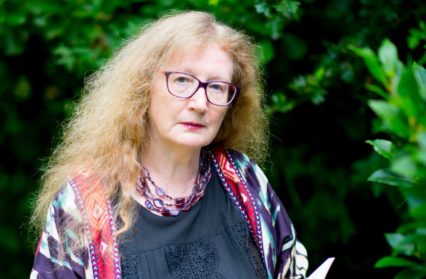In a fascinating insight into the writing process and the psychology of winning awards, writer Diana Powell reflects on the process of writing her short story ‘A Cure For All Our Ills’, which recently won the Bristol Short Story Prize.
The Bristol Short Story Prize is one of the most well-regarded writing awards, with its alumni regularly going on to win other major prizes, or being signed by some of the top literary agents and publishers.
Its judges are always highly experienced members from the writing community and representative of its different sectors. This year, they were Tom Drake-Lee, Associate Agent of the DHH Literary Agency, Jessica Taylor, co-owner of Minerva’s Bookshop in Bristol and regional sales manager for Penguin Random House and Irenosen Okojie M.B.E., vice-chair of the Royal Society of Literature, multi-prize-winning author, and B.B.C. podcast presenter.
When the results were announced in November at an awards ceremony in Bristol, I was both thrilled and shocked to find I had won. I had been delighted enough to be short-listed (one of two Welsh writers on there!). But to win was totally unexpected and I still find it hard to believe.
How could my simply-told story, ‘A Cure For All Our Ills’, have been chosen by those three eminent judges, with Irenosen Okojie hailing it as ‘A brilliant, hypnotic piece from an exciting voice. I had the feeling of holding my breath through this story. From its powerful, palpable opening, I was immediately invested. The use of tension, the exploration of religion, of sacred space becoming dark and unknown propels this world forward. Every word on the page is earned.’ Wow!
But what I am particularly pleased at is the fact that the story is set here in Wales, no more than a mile or two from where I live, in rural Pembrokeshire and is based on a tiny snippet of local folk tradition – and this was picked out from over two thousand international entries, from over seventy countries, including Brazil, Egypt, Malaysia, Nigeria and Vietnam.
I had had success with a local story before. My story, ‘Whale Watching’, had won the ChipLit Festival prize, was runner-up in the Society of Authors ALCS Tom-Gallon award and was published in the ‘Best (British) Short Stories 2020’ anthology. But that work featured a much-documented event in Fishguard’s history, and included a famous film, its director and a world-famous film-star…along with Moby Dick, the giant white whale of Herman Melville’s classic. (An article I wrote about ‘Whale Watching’ was published in the Wales Arts Review in November, 2020). Whereas this…
‘A Cure For All Our Ills’ began during lock-down in the pandemic, when restrictions on the time and distance of travel meant we were unable to reach the coast. Deprived of our usual jaunts, my husband and I dragged our bikes out and began cycling around the narrow country lanes that surrounded our house.
One day, we went up the hill, then turned down a narrow road, where, about a mile along, we noticed a church in the middle of fields – or, at least, we saw its tower, high and narrow, rising above the bushes and trees that circled it. It seemed a strange place for a church, with so few dwellings nearby and no apparent way to it.
Back home, I looked online, to see if I could discover something about it, and learnt that it was St. Edren’s, standing in a curvilinear (somewhat circular) churchyard, which usually suggests an earlier pagan site association. It was entirely re-built in 1846 and was made redundant and converted into a private dwelling in 1987.
All this was fairly commonplace, but there was another paragraph which was far more intriguing. The grass in the churchyard was regarded as protection for both men and cattle from the effects of the bite of a mad dog. The former should eat it with bread and butter, while the cows should simply graze on it.
And, on reading this, I immediately thought ‘ah, a story!’ – which is how most stories reach me.
Unfortunately, my writing hadn’t been going well during lockdown. At first, I couldn’t write at all; then, what I did write I wasn’t satisfied with. There were one or two bright spots – I managed third place in the TSS Cambridge prize with a new work. But on the whole, it wasn’t great.
But, as we moved out of pandemic restrictions and returned to normality (or some kind of it), I found myself eager to be writing again – and to write well. But what would my new story be about?
Among many other possibilities, I thought again of the church up the road, with the strange folk tradition attached to it. And, as so often happens in writing, this was the ‘story’ that spoke to me – it would be the one I would write next. I decided I needed to do some research on the subject. My stories often involve research and it’s something I enjoy very much – too much, sometimes, as I spend too long over it (a way of avoiding getting down to the actual writing, perhaps?).
The saint himself was an obscure figure, with his name switching between Edren, Edrin, Edrain, Edryn, Hedryn and Edeyrn (though I suspect the latter is a confusion with Cardiff’s ‘Edeyrn’, a rather better-known figure, a monk or a prince, possibly connected with King Arthur). There is even the possibility that ‘he’ was a ‘she’. His feast day is given as the 26th November. The church was situated nine or ten miles north west of Haverfordwest in the diocese of St David’s, as would be expected. Its one archaeological feature of note was the existence on the site of five carved early medieval stones, now located elsewhere. Moving from source to source, a few further details of the curious superstition began to emerge. Baring-Gould, in ‘The Lives of the British Saints’, mentions other animals besides cows, including horses, sheep and pigs, but these often refused to graze in the churchyard and died shortly after. He also mentions the case of a woman being bitten by a mad donkey… It also became apparent that the powers of healing attributed to the site originally came from a well.
Pembrokeshire has more wells than any other county in Wales – two hundred and thirty-six, according to Francis Jones, whose book ‘The Holy Wells of Wales’, is the seminal text on the subject. Some of these are ‘holy’ (associated with saints and their churches), some are for ritual, some are for cursing and some for healing.
‘Healing’ covered a number of ailments – often eyes (which may have been because where a spring left the earth resembled an eye), warts, rheumatism and also disorders of the mind. In the case of St Edren’s, this was particularly connected with the madness resulting from hydrophobia, or rabies. Unfortunately, over time, the well dried up. One local from long ago said this had been done intentionally, to drain the graveyard. Another account told of a farmer allowing a rabid dog to drink from it. Others blamed this on a curse, brought about by a woman who washed her clothes in it on a Sunday, therefore breaking the laws of the Sabbath (women often get the blame in these circumstances). Fortunately for the local inhabitants, the virtue of the water found its way into the surrounding grass, apparently by some miracle. And so this grass, known as ‘porfar cynddeiriog’, the grass of the mad, came to be eaten with, or between, slices of bread and butter, a sandwich.
And this privilege, or remedy, should be paid for with coins placed in a cavity in the church wall, such offerings being the perquisite of the parish clerk. So, all in all, there wasn’t much more than my original findings, beyond a few minor variations to the tale. At this point, I could have simply fictionalised the existing story, perhaps making more of the setting – which, after all, was very familiar to me – and turning it into little more than a new version of the folktale; a ‘once upon a time’, ending with a ‘happy ever after’, with, or without, a mad donkey.
But I wanted more.
And, sometimes, it is an advantage to have little knowledge of a subject, because this is when it becomes a matter for your imagination – something that is essential for all writers, able to take you and your reader anywhere. So, now, it was up to me. I had been playing with different narrative voices in various pieces. I like ‘you’ (second-person singular) very much. I also like ‘we’. Jo Lloyd used this so effectively in her BBC winning story, ‘The Invisibles’ (a wonderful piece of writing). I decided I’d like to try the same approach here – although, ultimately, the reader is in the head of one particular character. I don’t have female protagonists, exclusively, but I would say the majority of my stories are from a woman’s, or girl’s, point of view. As a writer, you can have your idea, the setting, your research, but there are other aspects of a story that have to arrive as if from nowhere – at least, that is how it works for me.
So it was in this instance. Suddenly, the three girls – Esther, Lizzie and Sarah – were clear in my mind, making their way to the church from different directions – one of them passing my house, from a farm (which, in fact, our ‘hamlet’ used to be), one from a cottage and the last from ‘the big house’, both of which can be found in the surrounding area. And Sarah, being ‘educated’, would be the narrator. While where the story set is clear, ‘when’ is unspecified, though it is obviously a time when Pembrokeshire was primarily a farming community (agriculture is still significant today), with no cars, no tourists, and when the Church dominated the lives of the people, while the old pagan ways were not forgotten. Indeed, the two often came together, as in ‘A Cure…’.
It is also a time when the way women’s bodies worked was a mystery, and when any deviance from the ‘norm’, as defined by a patriarchal society, was either regarded as a sin which had to be punished or an illness needing to be cured. In this story, Lizzie is an unmarried mother, distraught at having her baby taken away; Esther has a severe menstrual disorder, including psychological symptoms, and Sarah has had a lesbian relationship with her governess. Their families decide they are all suffering from afflictions of the mind and, as the grass in the churchyard was believed to cure a mad disease, they decide their daughters are prime candidates for eating it. Its sandwiches will ‘fix’ them.
There’s a quote by author Aminatta Forna, which I always refer to as relevant to my way of writing: ‘A story is like taking a thought for a walk’. And this is how it is for me. Now, I had added a voice to my background material and so the ‘walk’ began. I started with an introduction to the characters and place, hints, more than anything specific. I chose to drip feed the folktale into the narrative, between the background story of each of the girls. Indeed, this is what Sarah, the narrator, does within the tale, having been told all about the tradition by her governess, to explain why she was being made to undergo this suffering. It is also Sarah who leads the others up to the top of the church tower, to glimpse something beautiful, rather than the horror of the cemetery below.
And so, my ‘walk’ was going well, but where would it end?
The first version I wrote of the story – complete, ready to send out into the world – finished with the girls still on top of the tower, stepping… where? Although it was ambiguous, my thought was that they would all jump off together, to avoid their continued treatment, which was, of course, more like a ‘punishment’. Death would be the cure for all their ills. As it happens, a lot of my characters are dead, or about to die, at the end of my stories. This isn’t a deliberate choice, as in ‘I want to write about death’. It is simply where the ‘walk’ leads, on these occasions.
But I wasn’t happy. I was too fond of Sarah, Esther and Lizzie. It didn’t seem fair. Like so many authors, recently, I have been writing to reclaim stories for women. I wanted to do the same here. I wanted them to come out on top. I wanted it to be that what they had had to suffer somehow saved them… what they had had to eat – that grass, desecrated by cattle ordure and rotting corpses bursting from graves, that porfar cynddeiriog…
… the grass of the mad, which, going back to the original story, was a cure for rabies. What if an outbreak of rabies returned to the area? What would happen to all its inhabitants, then? And would I be able to change the ending of the story, successfully, and make it a better story, while bringing the tradition of the folktale full-circle?
Well, I won’t say, for those who haven’t read it – which, I hope very much you’ll do. It’s available in the anthology that includes the twenty shortlisted entries to the Bristol Prize – another great benefit of this award, containing the judges’ comments, together with photos and biographies of all the writers. (Available from https://tangentbooks.co.uk ).
And I hope you enjoy reading it, as much as I enjoyed writing it – this little story from a small corner of Wales.











